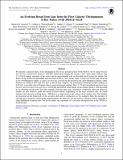| dc.contributor.author | Jaisawal, Gaurava K. | |
| dc.contributor.author | Wilson-Hodge, Colleen A. | |
| dc.contributor.author | Fabian, Andrew C. | |
| dc.contributor.author | Naik, Sachindra | |
| dc.contributor.author | Chakrabarty, Deepto | |
| dc.contributor.author | Kretschmar, Peter | |
| dc.contributor.author | Ballantyne, David R. | |
| dc.contributor.author | Ludlam, Renee M. | |
| dc.contributor.author | Chenevez, Jérôme | |
| dc.contributor.author | Altamirano, Diego | |
| dc.contributor.author | Arzoumanian, Zaven | |
| dc.contributor.author | Fürst, Felix | |
| dc.contributor.author | Gendreau, Keith C. | |
| dc.contributor.author | Guillot, Sebastien | |
| dc.contributor.author | Malacaria, Christian | |
| dc.contributor.author | Miller, Jon M. | |
| dc.contributor.author | Stevens, Abigail L. | |
| dc.contributor.author | Wolff, Michael T. | |
| dc.date.accessioned | 2021-02-05T21:40:55Z | |
| dc.date.available | 2021-02-05T21:40:55Z | |
| dc.date.issued | 2019-10 | |
| dc.date.submitted | 2019-06 | |
| dc.identifier.uri | https://hdl.handle.net/1721.1/129696 | |
| dc.description.abstract | We present a spectral study of the ultraluminous Be/X-ray transient pulsar Swift J0243.6+6124 using Neutron Star Interior Composition Explorer (NICER) observations during the system's 2017-2018 giant outburst. The 1.2-10 keV energy spectrum of the source can be approximated with an absorbed cutoff power-law model. We detect strong, luminosity-dependent emission lines in the 6-7 keV energy range. A narrow 6.42 keV line, observed in the sub-Eddington regime, is seen to evolve into a broad Fe-line profile in the super-Eddington regime. Other features are found at 6.67 and 6.97 keV in the Fe-line complex. An asymmetric broad-line profile, peaking at 6.67 keV, is possibly due to Doppler effects and gravitational redshift. The 1.2-79 keV broadband spectrum from Nuclear Spectroscopic Telescope Array (NuSTAR) and NICER observations at the outburst peak is well described by an absorbed cutoff power law plus multiple Gaussian lines and a blackbody component. Physical reflection models are also tested to probe the broad iron-line feature. Depending on the mass accretion rate, we found emission sites that are evolving from ∼5000 km to a range closer to the surface of the neutron star. Our findings are discussed in the framework of the accretion disk and its implication on the magnetic field, the presence of optically thick accretion curtain in the magnetosphere, jet emission, and the massive, ultrafast outflow expected at super-Eddington accretion rates. We do not detect any signatures of a cyclotron absorption line in the NICER or NuSTAR data. | en_US |
| dc.description.sponsorship | NASA (Grant HST-HF2-51440.001) | en_US |
| dc.language.iso | en | |
| dc.publisher | American Astronomical Society | en_US |
| dc.relation.isversionof | http://dx.doi.org/10.3847/1538-4357/AB4595 | en_US |
| dc.rights | Article is made available in accordance with the publisher's policy and may be subject to US copyright law. Please refer to the publisher's site for terms of use. | en_US |
| dc.source | The American Astronomical Society | en_US |
| dc.title | An Evolving Broad Iron Line from the First Galactic Ultraluminous X-Ray Pulsar Swift J0243.6+6124 | en_US |
| dc.type | Article | en_US |
| dc.identifier.citation | Jaisawal, Gaurava K. et al. "An Evolving Broad Iron Line from the First Galactic Ultraluminous X-Ray Pulsar Swift J0243.6+6124." Astrophysical Journal 885, 1 (October 2019): 18 © 2019 The American Astronomical Society | en_US |
| dc.contributor.department | MIT Kavli Institute for Astrophysics and Space Research | en_US |
| dc.relation.journal | Astrophysical Journal | en_US |
| dc.eprint.version | Final published version | en_US |
| dc.type.uri | http://purl.org/eprint/type/JournalArticle | en_US |
| eprint.status | http://purl.org/eprint/status/PeerReviewed | en_US |
| dc.date.updated | 2020-09-21T18:29:16Z | |
| dspace.date.submission | 2020-09-21T18:29:19Z | |
| mit.journal.volume | 885 | en_US |
| mit.journal.issue | 1 | en_US |
| mit.license | PUBLISHER_POLICY | |
| mit.metadata.status | Complete | |
